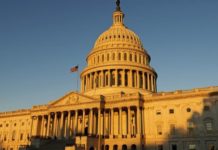
Remember the economy of seven months ago? Until March it was growing at an impressive pace, but the Covid crisis makes it seem distant. With the election approaching, America should refresh its memory of the policies—namely, tax cuts and deregulation—that helped drive growth before the pandemic.
When President Trump took office in 2017, the recovery from the 2008-09 recession was in its seventh year. After years of slow but sustained growth, many analysts expected another downturn. The Congressional Budget Office predicted that from 2017 through 2020 real gross domestic product would grow by only 1.9% a year, and the labor force would expand by only 0.7% a year. Progressive economists called this outlook “secular stagnation,” saying the sluggish growth was largely immune to policy changes.
Free-market economists, including many who eventually staffed the Trump administration, rejected that pessimistic view about the economy’s potential, arguing instead that reducing tax and regulatory burdens would increase productivity and make capital and labor markets more efficient.
By the end of 2017 the White House and a Republican Congress lowered the corporate tax rate from 35% to 21%, allowed businesses to expense capital costs upfront, and reduced tax rates on small businesses and individuals. They also repealed the regulatory burdens on several industries. The Congressional Review Act was fast-tracked to reduce regulation legislatively. Key appointments led to more rigorous use of cost-benefit analysis in the Securities and Exchange Commission, Federal Deposit Insurance Corp., National Labor Relations Board and Environmental Protection Agency. Burdensome and unproductive stress tests on community banks were eased.
These policies were based on the simple idea that economic improvement comes from creating greater opportunities for individual self-improvement. Policies that interfere with free markets destroy opportunities.
The tax and regulatory policies, designed primarily to enhance long-term economic growth, had an immediate beneficial impact until the onset of the pandemic early this year. The strong GDP growth and record low unemployment from January 2017 through the end of 2019 reflect a policy success. Real GDP grew nearly 40% a year faster than the CBO predicted. The labor force grew nearly 50% faster. Productivity growth, which drives up wages, nearly doubled, from 0.8% a year between 2013 and 2016 to 1.5% a year from 2016-19. In the past few months, as state and local shutdown orders have been relaxed, the economy’s strong fundamentals have helped growth return quickly.
These top-line numbers only begin to describe the impact of the Trump administration’s economic policies. A more thorough investigation reveals how countless segments of society rose with the upward trend.
Wages increased across all education levels, with the largest increase, 12%, occurring among workers with less than a high school education.
Similarly, inflation-adjusted median family income increased in all quartiles of the income distribution. The largest increase occurred among the poorest fourth of U.S. households and the second largest in the second-poorest fourth.
The poverty rate declined across a large cross-section of the country, reaching a record low for a roughly three-year period. The poverty reductions from 2016-19 were largest among people of Asian descent (28%), followed by Hispanics (19%), whites (17%) and African-Americans (15%). Correspondingly, the number of persons receiving food stamps declined by 10% and the number relying on federal disability insurance dropped 6%.
You don’t hear disparaging remarks these days about “trickle down” economics. The aforementioned data is why.
Now the direction of federal economic policy is on the ballot. President Trump has promised to continue deregulation and tax reform. Joe Biden vows to undo these policies and in some cases to go far beyond the Obama administration. He plans to raise the top income-tax rate to 43.4%, tax high earners’ capital gains and dividends at the same rate as ordinary income, increase the payroll tax to 12.4% for people earning over $400,000, and raise the corporate income-tax rate to 28%. Mr. Biden’s regulatory agenda includes taking an irreversible step toward national health insurance by creating a public option, restricting oil and gas production, and imposing limits on carbon emissions that would depress a variety of productive industries.
The coronavirus and lockdowns have had a devastating impact on workers and businesses, and have made prosperity feel distant. But we shouldn’t forget the widespread gains that came from sound economic policies as recently as this spring. As good as the economy was, it could be even better. To reach full potential, Americans should elect a president and Congress that will restrain federal spending to keep debt at bay, reverse restrictive trade policies, and a return to a more-predictable, rules-based monetary policy.
Countless issues are at stake in November. But economic policy deserves to be foremost in voters’ minds. It may be the most important issue of all.
Mr. Cogan is author of “The High Cost of Good Intentions.” Mr. Taylor is a professor of economics at Stanford, and co-author, with George P. Shultz, of “Choose Economic Freedom.” Both are senior fellows at the Hoover Institution.






